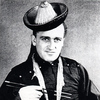THANGKA, akvarell på papper. Tibet, 17/1800-tal.
Avbildande Avalokiteshvara som är känd som den "Allseende guden med tusen händer och elva ansikten". Hans tusen armar bildar en ring runt hans kropp, de sex huvudarmarna håller bl.a. i en mala, en dharmachakra, en loutsgren samt långa livets vas. Han bär en lång dhoti med skärp och ornament. Runt honom svävar lamor och gudomar. Motivets mått 30x60 cm. Mått med ram 59x91 cm.
Provenance: Formerly in the collection of Danish Archaeologist, Ethnographer, Art Collector and Museum Director Werner Jacobsen (1914-79). For more information, see below.
Skador, slitage.
Proveniens
Formerly in the collection of Danish Archaeologist, Ethnographer, Art Collector and Museum Director Werner Jacobsen (1914-79). Jacobsen studied archeology and participated 1938-39 in the Danish Royal Geografic Societys Expedition to Mongolia under the lead of Henning Haslund-Christensens.
During the years 1946-59 he lived in India and Nepal and acquired many pieces for National Museum in Denmark, The Royal Library, the Moesgård Museum and himself. He set up a scientific center in Kathmandu, Nepal and later in Denmark where he organized all the material and information he had gathered.
In 1940-45 he was employed the Danish National Museum, in 1961 he became Museum Director for the Etnografic Collection. 1963-78 he was the head of the information and educational Department at the Museum. The collection was acquired from Werner Jacobsen as a whole when he sold it to gather funds for new expeditions. Thence by descent to the present owner.
Litteratur
Werner Jacobsen published various literary and academic works such as; Bronzer fra Mongoliet, Köpenhamn, 1940, Some Observations on the Origin of Sino-sibirian Animal Bronzes, Köpenhamn 1941, Buddhsitisk Skulptur I Kina, Köpenhamn, 1941, Kabuki, det Japanska folks teater, Köpenhamn 1941, Todaerne, - en idisk bjergstamme, Köpenhamn 1949, Maleri fra Puri, Orissa, Indien, Köpenhamn 1961, Thailand, Arkeologi og Kunst, Köpenhamn 1961. Originale Bloktryk fra Nepal, Köpehamn, 1966, Asiatiske Akkorder, Köpenhamn 1965, Buddha og det modern menneske, Köpenhamn, 1970, Kunsten, kunstneren og inderen, Köpenhamn, 1970, Den hvide mans byrde, Köpenhamn, 1970, Hvad er den egentlige virkelighed, Köpenhamn, 1976, Den hvide gud, Köpenhamn, 1973.
Övrig information
Avalokitesvara has a number of Body parts and objects with symbolic meaning. Of his 11 heads, the central head one at the top belongs to Amitabha. He often has multiple arms, sometimes more than a thousand of them. The central pair of hands is in the cupped position representing respect. In one hand he hold a Lotus, symbolizing Enlightenment, In another he holds a bow and arrow, symbolizing a Bodhisattva’s ability to get at the Heart of the matter.
Avalokitesvara appears in 33 different manifestations and 108 forms, including the Goddess of mercy, popular with pregnant mothers and invoked by people in trouble. Simply repeating her name several times is considered enough to drive away Evil.



































